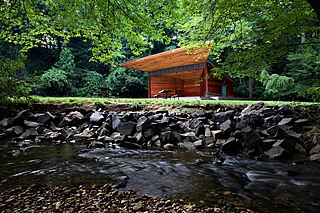Portal:Virginia
The Virginia Portal  Virginia, officially the Commonwealth of Virginia, is a state in the Southeastern and Mid-Atlantic regions of the United States between the Atlantic Coast and the Appalachian Mountains. The state's capital is Richmond and its most populous city is Virginia Beach. Its most populous subdivision is Fairfax County, part of Northern Virginia, where slightly over a third of Virginia's population of 8.7 million live. Eastern Virginia is part of the Atlantic Plain, and the Middle Peninsula forms the mouth of the Chesapeake Bay. Central Virginia lies predominantly in the Piedmont, the foothill region of the Blue Ridge Mountains, which cross the western and southwestern parts of the state. The fertile Shenandoah Valley fosters the state's most productive agricultural counties, while the economy in Northern Virginia is driven by technology companies and U.S. federal government agencies, including the U.S. Department of Defense and Central Intelligence Agency. Hampton Roads is also the site of the region's main seaport and Naval Station Norfolk, the world's largest naval base. (Full article...) Selected article
At the Battle of Malvern Hill (July 1, 1862) during the American Civil War, the Confederate Army of Northern Virginia under the command of General Robert E. Lee and the Union Army of the Potomac under General George B. McClellan clashed near Richmond, Virginia, the Confederate capital.
Confederate commander-in-chief Joseph E. Johnston had fended off McClellan's repeated attempts to take the city of Richmond as part of McClellan's ambitious Peninsula Campaign. After Johnston was wounded, Lee took command and launched a series of counterattacks, collectively called the Seven Days Battles, culminating in the action on Malvern Hill. The battle involved over fifty thousand soldiers from each side, hundreds of pieces of artillery and three warships. The Union V Corps, under Fitz John Porter, took up positions on the hill on June 30 in preparation for the battle, which began the following day. Confederate preparations were hindered by several mishaps. Nonetheless, the Confederates attacked first, when the artillery on the left flank began firing upon the Union line. The Federal artillery, however, was the story of the day, repulsing attack after attack. In the aftermath of the battle, the Confederate press heralded Lee as the savior of Richmond. McClellan was criticized harshly for his absence from the battlefield, an issue that would haunt him when he ran for president in 1864. From Malvern Hill, McClellan and his forces withdrew to Harrison's Landing where he would stay until August 16. Lee withdrew to Richmond to prepare for his next operation, as the action on Malvern Hill ended the campaign on the Peninsula. Selected biography
Patrick Henry (May 29, 1736 – June 6, 1799) was an American attorney, planter, and orator best known for his declaration to the Second Virginia Convention (1775): "Give me liberty, or give me death!" A Founding Father, he served as the first and sixth post-colonial Governor of Virginia, from 1776 to 1779 and from 1784 to 1786.
Henry was born in Hanover County, Virginia, and became a lawyer through self-study. Beginning his practice in 1760, he soon became prominent through his victory in the Parson's Cause against the Anglican clergy. Henry was elected to the Virginia House of Burgesses, where he quickly became notable for his inflammatory rhetoric against the Stamp Act of 1765. In 1774 and 1775, Henry served as a delegate to the First and Second Continental Congresses, but did not prove particularly influential. He gained further popularity among the people of Virginia, both through his oratory at the convention and by marching troops towards the colonial capital of Williamsburg after the Gunpowder Incident until the munitions seized by the royal government were paid for. Henry urged independence, and when the Fifth Virginia Convention endorsed this in 1776, served on the committee charged with drafting the Virginia Declaration of Rights and the original Virginia Constitution. Henry was promptly elected governor under the new charter, and served a total of five one-year terms. After leaving the governorship in 1779, Henry served in the Virginia House of Delegates until he began his last two terms as governor in 1784. The actions of the national government under the Articles of Confederation made Henry fear a strong federal government and he declined appointment as a delegate to the 1787 Constitutional Convention. He actively opposed the ratification of the Constitution, a fight which has marred his historical image. He returned to the practice of law in his final years, declining several offices under the federal government. Henry is remembered for his oratory, and as an enthusiastic promoter of the fight for independence. This month in Virginia history
Random Virginia articleA random generator will select an article about… 
(note: generator may be slow) Things you can do
Tasks
Selected image The Meadow Pavilion at the Wolf Trap National Park for the Performing Arts, Fairfax County, Virginia Did you know -
Fact sheet
State symbols:
Government
Related portalsVirginia topicsSubcategoriesSelect [+] to view subcategories
Associated WikimediaThe following Wikimedia Foundation sister projects provide more on this subject:
Discover Wikipedia using portals |



























